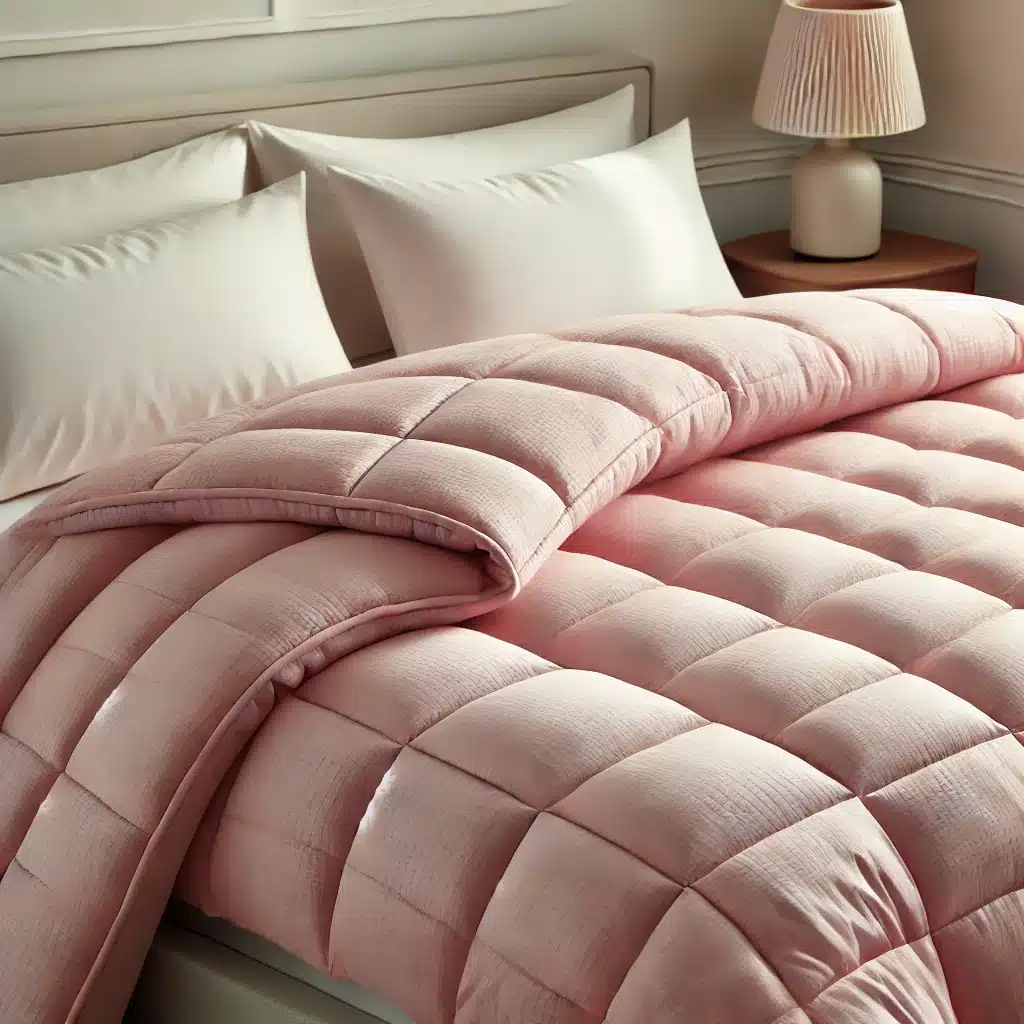Bamboo comforters are light, breathable, and cozy in every season—but only if you treat them right. Don’t worry, though. Taking care of one isn’t complicated. A few easy habits can help yours stay in top shape for years.
This isn’t just a list of instructions—it’s real, practical advice. From avoiding clumps to dodging mildew, here’s how to keep your bamboo comforter soft, clean, and ready for sleep. If you’ve been searching for clear and simple bamboo comforter care tips, you’re in the right place.
Still deciding if bamboo’s right for you? This post on bamboo comforters can help clear things up.
Sections to Check Out
Quick Care Checklist for Bamboo Comforter Care
No time to scroll? Here’s a quick hit list of what works:
- Always use a duvet cover
- Wash only when needed (every 3–6 months)
- Spot clean with cold water and mild soap
- Cold wash, gentle cycle, no bleach or softeners
- Air dry flat or tumble dry low with wool dryer balls
- Store it in a cotton bag—not plastic
Choosing the Right Size
The right size can make all the difference in how well it fits your bed—and how comfortable you feel at night. Some people prefer a slightly oversized comforter for extra coverage, while others stick with standard sizes for easier handling and washing. Here are the most common sizes:
- King (108″ x 96″) – Ideal for shared beds or those who prefer extra draping. Works well on a queen bed if you want more coverage.
- Queen (90″ x 90″) – A great fit for most standard queen-sized beds, offering the right balance between coverage and ease of washing.
- Full/Double (80″ x 90″) – A good choice for full-size beds, guest rooms, or single sleepers who like extra coverage.
- Twin (68″ x 86″) – Best suited for kids, bunk beds, or anyone who wants a lightweight, easy-to-care-for option.
When considering your bamboo comforter care options, think about how the size affects washing and maintenance. Proper bamboo comforter care includes choosing the right size to make cleaning easier.
If you love a plush, cozy feeling, consider sizing up for extra drapes on the sides—just like high-end hotel bedding!
For effective bamboo comforter care, it’s vital to know how to maintain the comforter’s fill. Shake your bamboo comforter regularly to keep the filling evenly distributed, promoting better insulation and comfort.
Year-Round Comfort Without the Hassle
This is where bamboo really shines. It’s naturally breathable, so it works for both hot sleepers and chilly nights. Here’s how to tweak things for each season:
Winter Tips:
- Layer a blanket underneath for extra warmth
- Use a flannel duvet cover to hold in heat
- Consider a bamboo-down blend if you tend to sleep cold
Summer Tips:
- Skip extra layers—bamboo works great on its own
- Let airflow do its job: crack a window or use a fan
Want cooling comfort even in July? You’ll find options in this list of the best bamboo comforters.
Shopping for One? Read This First
Not all bamboo comforters are made the same. If you’re buying a new one, here’s what actually matters:
Bamboo is one of the most renewable bedding materials—it grows quickly, needs little water, and doesn’t rely on heavy pesticides. And when you care for your comforter the right way, it lasts longer and stays out of landfills. That’s a win for both comfort and the planet.
- Tight weave to keep fill inside
- Filling: 100% bamboo is softer, blends are more affordable
- Box stitching: Fewer cold spots, no lumpy corners
- OEKO-TEX certified: Safer for your skin
Is sensitive skin a problem? Here’s more on why bamboo bedding works well for that.
How Does It Compare? Bamboo vs. Other Comforters
| Feature | Bamboo | Cotton | Down | Polyester |
|---|---|---|---|---|
| Breathability | Excellent | Good | Moderate | Low |
| Moisture-wicking | Yes | Moderate | No | No |
| Hypoallergenic | Naturally | Sometimes | Often not | Often not |
| Eco-friendliness | High (fast-growing) | Moderate | Low (animal-based) | Low |
| Care Difficulty | Moderate | Easy | High | Easy |
| Longevity | 5–10 years | 3–5 years | 10+ years (high care) | 3–5 years |
Professional Cleaning vs. Home Washing
So, how often should you wash it? Not often. If it’s covered with a duvet, every 3–6 months is usually enough. That’s part of why bamboo comforter care is easier than you might think. And because they don’t need frequent washing, you end up saving water and energy—another plus if you’re trying to make more eco-conscious choices while keeping up with bamboo comforter care.
At Home:
- Use cold water, gentle cycle
- Wash it solo—no towels or jeans in there
- Mild detergent only (enzymatic or plant-based is best)
- No bleach, no fabric softener—those break down the fibers
Why it matters: Harsh cleaners can wear down bamboo’s softness. Fabric softeners leave behind a residue that makes it feel stiff—not what you want.
Drying:
- Lay it flat if you can. If not, tumble dry low
- Add a few wool dryer balls to keep it from clumping
- Reshape halfway through drying if needed
- Make sure it’s fully dry before you fold it up
Indoor vs. Outdoor Drying:
- Indoor drying protects it from UV damage and pollen
- Outdoor drying gives a fresher scent and can help with odor, but avoid strong sun to prevent fading
Pro Tip: Got a king-size one? Professional cleaning might be worth it. Expect to pay around $25–$50. Most dry cleaners know how to handle bamboo.
Spills Happen—Here’s What to Do
Don’t panic if something spills. You don’t need to wash the whole thing.
- Blot gently with cold water and mild soap
- Don’t rub or scrub—just dab
- Let it air dry fully before using again
Spot-Specific Tips:
- Sweat or body oil: Mix a little white vinegar with water and dab gently
- Coffee or tea: Use baking soda paste and rinse lightly
- Makeup: Use a drop of gentle dish soap—nothing oil-based
- Blood: Dab with cold water and a touch of hydrogen peroxide. Always test a small spot first to avoid discoloration. of gentle dish soap—nothing oil-based
Pro Tip: If your pet naps on your bed, a duvet cover will save you from way more cleanups than you’d expect.
Storing It Off-Season? Do It Right
Done using it for the summer, or pulling it out for winter? Storage matters more than you think. Storing a damp comforter—even slightly—can lead to mildew, so always make sure it’s completely dry first.
- Use a breathable cotton bag (never plastic)
- Avoid damp places like basements or attics
- Toss in cedar blocks to keep pests away
- Let it air out now and then, even in storage
If you want to freshen it up without a wash, a light mist of fabric spray made for bedding can help—just don’t overdo it. Avoid essential oils directly on the fabric.
Troubleshooting Common Problems
Even with regular bamboo comforter care, a few issues can still pop up. Here’s how to handle them:
- My bamboo comforter smells after washing—what now? New comforters sometimes come with a mild factory scent—nothing to worry about. Just let it air out in a dry, shady spot with good airflow. Avoid strong sun, though—it can fade the fabric over time.
- It’s gone flat. Can I fix it? Toss it in the dryer on low with a couple of wool balls or clean tennis balls for 10–15 minutes. It’ll fluff back up.
- Fill keeps shifting: Daily fluffing helps. If yours isn’t box-stitched, consider replacing it next time.
- Fabric looks pilled or worn: Avoid washing with rough laundry. And if your duvet cover’s looking tired, swap it out—it might be causing friction.
Myth vs. Fact
Myth: Bamboo comforters can’t be washed at home.
Fact: Many are machine washable—just use a gentle cycle and mild detergent.
Myth: Bamboo bedding is always 100% bamboo.
Fact: Some comforters are bamboo blends. That’s fine—just adjust care slightly depending on the fill.
Myth: They don’t last long.
Fact: With the right care, most bamboo comforters last up to a decade.
Allergies or Sensitive Skin?
Bamboo’s tight weave naturally repels dust mites and bacteria, which makes it a good fit if you’re allergy-prone. Regular airing and less frequent washing also help preserve its skin-friendly qualities.
When to Say Goodbye
Comforters don’t last forever—even the good ones. Here’s how to know yours is nearing the end:
- It feels flat and lifeless, no matter how much you fluff it
- It smells off, even after washing
- The fabric looks worn or thinned out
Most bamboo comforters last 5–10 years if you take care of them, and that means fewer replacements in the long run, which helps reduce waste.
Frequently Asked Questions
- Is a bamboo comforter worth it? Yes—if you’re looking for breathable, lightweight bedding that works year-round. Bamboo comforters are more sustainable than most options, and with the right care, they last years.
- What’s the difference between a comforter and a duvet? A comforter is ready to use as-is, while a duvet is usually an insert meant to go inside a cover. Bamboo comforters often work well either way, but using a duvet cover helps with care and longevity.
- Do bamboo comforters wrinkle easily? They can wrinkle a little, especially if stored folded. But wrinkles smooth out naturally once the comforter is fluffed or placed on the bed.
- How long do bamboo comforters last? With regular care, most last 5–10 years. Use a duvet cover and avoid overwashing to stretch its lifespan.
- Are bamboo comforters fluffy? They’re more light and breathable than lofty. If you like that cloud-like fluff, go for a bamboo blend with down alternative for more loft.
Wrapping Up Your Bamboo Comforter Care Routine
If your bamboo comforter already makes your bed feel better, keeping it clean is the next step. And now, it shouldn’t feel like a chore. A little attention here and there goes a long way—and means fewer late-night regrets when you pull it out of the closet next season. Stick with smart bamboo comforter care, and it’ll keep doing its job.
If you’re ready to upgrade your sleep, check out these Top 5 Eco-Friendly Bamboo Comforters & Duvets..

Kristin is the founder of Eco Bamboo Living. She shares honest, research-backed guides and product reviews to help readers find bamboo products that are truly sustainable, practical, and worth bringing into their homes.

